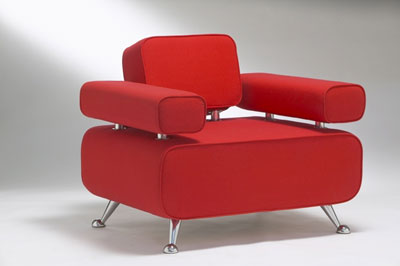The Modern or Contemporary design age in furniture begins roughly with the start of the 20th century. Following are the most popular Contemporary furniture styles created after 1800 — sleek designs that prompted the move from the more ornate Historic style.
Shaker (1830-1850): Shaker furniture designs are plain in appearance, stripped to bare essentials (few turnings, no decorations), featuring natural materials; no ornamentation; strong emphasis on function.
Gothic Revival (1851-1914): Gothic Revival furniture emphasized natural materials. Designs based on nature. Handcrafting versus machine-made. Arched-top chair crests, rails and knobs, and lots of turnings show up today in side chairs for the dining room and kitchen.
Adirondack (1890s-present): Rustic, natural, often made of bark-covered logs or simple planks. Look for junk shop finds when in the country (for authenticity), or purchase hand-made new versions of these comfy furnishings, which translate into today’s Lodge Look that also contains Western motifs and icons.
Art Nouveau (circa 1900): The first new style not using any historical reference was based on flowing lines of leaves and vines and influenced by Japanese art.
Arts and Crafts/Mission in America (circa 1900): Simple designs executed in natural wood. Emphasized hand craftsmanship, quality materials, and strong, clean lines. Also called Golden Oak. Widely seen in today’s Stickley chairs and other furniture that uses the same designs as earlier origins.
Art Deco (1918-1939): Fashion-oriented. Influenced by primitive art and cubism. More color, pattern, and grand ornamentation, including motifs such as zigzags, electricity bolts, and skyscrapers. Often seen today in headboards and accent chairs.
Bauhaus (1919-1933): Design based on unifying art and technology. Little ornamentation. Function, form, and materials (metal tubing, glass, and other technological, machine-made materials) most important. Emphasis placed on machine-made, efficient production.
International Modern (1925-1947): No regional influences, historic references, ornamentation, or unnecessary elements is what made Modern furniture so radical in its time. Details come from the interesting use of modern materials. Emphasis is on machine-age technology — the house as a machine for living.
High Tech (1980-1990s): Emphasis on exploitation and exposure of elements of science and technology for home use. Shows the construction of the interior. Uses industrial materials for the home. Electronic and space age details important. Celebrates and makes room for the machine.
Contemporary: Contemporary combines influences, trends, and new technologies without strict adherence to any one design philosophy. Current trends include designs that blend styles and periods but are streamlined for today’s taste.
> >
>Credit: www.officeinstallationservices.com>
Contemporary furnishings blend traditional styles with modern lines.
>
dummies
Source:http://www.dummies.com/how-to/content/contemporary-furniture-styles.html
No comments:
Post a Comment